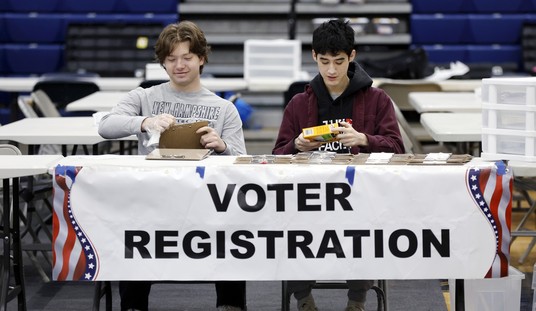About 2 weeks ago, I wrote an article quoting another publication’s claim that the Environmental Protection Agency (EPA) Chief, Lisa Jackson, had called Republicans “Jack Booted Thugs.” And, while I accurately quoted the original article which had made the claim, that publication subsequently retracted the quote saying that it was incorrect and we at RedState promptly issued a retraction as well (you can read a summary of the event here).
So let me magnanimously offer my sincerest…
[youtube]ZILiWD3O8cg[/youtube]
… well wait a moment. Before I finish that sentence, I’d like to get some other house cleaning in order.
Let’s start with news that the EPA has taken it upon themselves to shield the public from concerns that they themselves have in regards to the reliability of accessibility to electricity following the implementation of the Maximum Achievable Control Technology (MACT) rule.
In a “What are the energy impacts?” section, the EPA concedes that it “is aware that concerns have been expressed by some, even in advance of this proposed rule, that this regulation may detrimentally impact the reliability of the electric grid.” The agency admits that what it calls “sources integral to reliable operation” may be forced to shut down—those would be the coal-fired plants the EPA is targeting—and that these retirements “could result in localized reliability problems.” The EPA insists that it knows how to balance “both clean air and electric reliability,” but all along in public it has denied that reliability is in any way at risk.
[…]
But here’s the kicker: This reliability section was gone when the EPA released its utility rule proposal in May 2011.
(emphasis mine)
This is an interesting turn of events which raises the obvious questions: Who decided to omit it from the final reliability report? Why was it omitted? Have the concerns been addressed?
These are all legitimate questions of course, but they are being wholly ignored by Jackson and the EPA:
On Wednesday Senators Lisa Murkowski and James Inhofe sent another letter to EPA chief Lisa Jackson, after Ms. Jackson refused to answer letters of August 3 and 16 and September 7 about reliability. The Senators modestly ask the EPA not to “impair electric reliability and affordability,” though they also ask “why and on what legal basis” the agency buried its own reliability announcement. (emphasis mine)
The simple answer is that they have none. But jumping through the hoops required to actually delete an important portion of the report seems unnecessary given the agency’s apparent willingness to distort facts.
Case in point, this quote from Ms. Jackson on the business sense of the EPA:
“For every $1 we have spent, we have gotten $40 of benefits in return. So you can say what you want about EPA’s business sense. We know how to get a return on our investment.”
The spending that Jackson is referring to here is the tax-payer money that the EPA outlays to create and enforce its regulations.
The benefits are a different story and are outlined in The Benefits and Costs of the Clean Air Act from 1990 to 2020 released in April of this year.
“…Our primary central estimate implies that PM [particulate matter] and ozone reductions due to the CAAA [Clean Air Act Amendments of 1990] in 2020 will result in 230,000 avoided deaths, with a primary low and primary high bound on this estimate of 45,000 and 490,000 avoided deaths, respectively. These avoided deaths are valued at $1.8 trillion (2006$), with primary low and primary high bounds on this estimate of $170 billion to $5.5 trillion.
It’s worth mentioning that the benefits expected through these regs has increased 10 fold from the last time these projections were made (during the Clinton Administration) which speculated a mere $170 billion. Quite the monumental jump in benefits at roughly the same time that the most ‘green’ friendly president in history got into the White House after having expressed his desire to force us off of our coal dependency.
How these numbers translate into a 40:1 cost-benefit ratio involves more calculations than I have time to relay here, but the fact remains: the EPA expects their rules post 1990’s amendments (which includes the most recent proposed rules) would save a lot of money and a lot of lives.
But is there any basis for it? Depends on your willingness to suspend diligence and objectivity. Something the EPA basically admits in their report:
In the end, however, there is no way to validate the counterfactual, without-CAAA scenario estimates.
Translation: They can’t possibly know what the conditions would be without the CAAA so therefore must guess and that guess is based on zero factual data and complete ignorance of trends in technology. The coal industry and industrial sector has vastly improved their own emissions both before and after the original CAA (Clean Air Act) in 1963 and in keeping with their own goals of safe and profitable enterprises that don’t kill people, were continuing with technological improvements that helped make the world cleaner. However, the assumptions in the EPA’s report completely omit this information and assume that over the lifetime of their assumptions, not one change in air quality would have happened without their intervention.
In other words, it’s a useless prediction completely devoid of meaning.
Moreover, the EPA acknowledges in this report there are “major uncertainties” (their words) which should make even the staunchest believer take pause.
For example:
- the report authors acknowledge that they have an “inability to conclusively state that PM [parrticulate matter] mortality outcome is causal.” In other words, they have no idea if anything they’re talking about will actually result in preventing PM deaths. In fact, the report authors fully acknowledge that their report has a +/- margin of error of an astounding 84/79 percent. In spite of this glaring unknown, PM-related deaths constitute the largest portion of the deaths in study.
- In the report summary (also available at the EPA) they admit in the fine print that making these assumptions is based on how they choose to outlay the data. One would think that they might want to take the conservative rout and assume the least. One would be wrong: “Models for cessation lag which assume that a substantial proportion of the risk reduction occurs many years after the air quality improvement can lead to significantly lower estimates for the economic value of that improvement. Conversely, cessation lag models which assume most or all of the risk reduction occurs shortly after the air quality change can result in higher benefit estimates.” Translated, this simply means that they chose to use a set of assumptions that most increased the perceived benefit and have since peddled the information as fact.
There are of course dozens of other admissions throughout the 238 page report and 35 page summary. However, they are all looked past or rationalized since their ability to use the regulatory system to shut down coal hinges on their ability to prove they are saving lives. In the end, they have little to no evidence that this is what is being accomplished other than a laundry list of wishful thinking and faulty assumptions clothed in an official report.
And all of this guessing is in stark contrast to the predictions made by industry leaders as to how the rules will affect their own businesses and thus the economy at large. Unsurprisingly, the EPA’s decision to scrub the electrical grid concerns has a quieting effect on businesses that are saying things could get rough.
Since the results of the imposition of these proposed rules are quantifiable (unlike the assumptions used to justify their existence) the energy sector has been more than capable of outlining how things will unfold once they are in effect. And the problems will be significant.
From limitations on power causing strains on the grid and thus blackouts, to job losses in the range of 1.44 million 1.65 million over the next 10 years (and by the way, that does take into account any new jobs created via the ‘green’ industry though it’ll probably be higher if these ‘green experiments like Solyndra keep failing), the EPA is using a set of lies, half-truths, and extreme-enviro ideology to perpetrate the destruction of the coal industry (at the explicit and very public request of President Obama) and the long awaited arrival of Al Gore’s carbon trading empire. All with zero approval from Congress since they’ve couched it all within the Clean Air Act (CAA) which arguably doesn’t permit them to take any of these actions in the first place.
But this is about my misquoting Ms. Jackson. Perhaps I do owe her an apology for relaying the quote misattributed to her by Greenwire. It turned out there was a youtube video of the speech that I could’ve used to confirm the quote but I assumed it had been closed door and as such, didn’t look for it. That failure of research required me to swallow my pride and acknowledge (via Moe Lane who kindly added the correction to the post) that I’d put out a sloppy report riddled with errors (well, one error).
Now that I’ve gotten that out in the open, the healing can begin. Is there any research failing, radical assumption making, impossible to prove, propoganda-ish bit of writing from your department that you’d like to talk about Ms. Jackson?














Join the conversation as a VIP Member